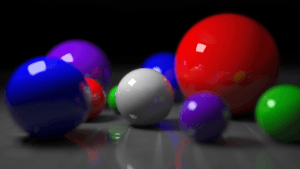Ray tracing facts for kids
Ray tracing is a clever computer trick that helps make super realistic 3D pictures and videos. Imagine seeing a movie or playing a video game where everything looks incredibly real, with perfect reflections and shadows – that's often thanks to ray tracing!
Contents
What is Ray Tracing?
Ray tracing is a powerful algorithm used in computer graphics. It creates images by tracing the path of light. It works by following light rays as they bounce around a virtual scene. This method helps computers draw scenes that look just like real life.
How Does Ray Tracing Work?
Think of it like this: when you look at something, light rays travel from the object to your eyes. Ray tracing works backward. The computer sends out imaginary "rays" from the camera's point of view. These rays are like tiny lines of sight.
- Each ray travels into the virtual scene.
- When a ray hits an object, the computer figures out what color that spot should be.
- It also checks for light sources, shadows, and reflections.
- If the object is shiny, the ray might bounce off it.
- The computer then traces this new bounced ray.
- This process continues until the ray hits a light source or goes too far.
- All this information helps the computer decide the final color of each tiny dot (pixel) on your screen.
Rays and Light
In the real world, light comes from a source (like the sun or a lamp). It then hits objects and bounces off them. Some of this light travels to our eyes, allowing us to see. Ray tracing tries to copy this natural process. By tracing how light interacts with objects, it can create very accurate shadows, reflections, and refractions (how light bends through clear objects like glass).
Why Is Ray Tracing So Realistic?
Ray tracing makes images look real because it handles light in a very natural way. Older methods of drawing computer graphics often used shortcuts. These shortcuts were faster but didn't always look perfect. Ray tracing, however, calculates how light behaves for every single ray.
- Reflections: Surfaces like mirrors or polished floors will show clear reflections. Ray tracing calculates these reflections accurately.
- Shadows: Shadows look soft and realistic, changing based on the light source. Objects block light, creating dark areas just like in real life.
- Refraction: When light passes through clear objects, it bends. Ray tracing can show this bending effect, making water or glass look very convincing.
- Global Illumination: This is how light bounces around a whole scene. For example, a red wall might cast a faint red glow on a nearby white wall. Ray tracing can capture these subtle effects.
Where Is Ray Tracing Used?
Ray tracing is used in many exciting areas where realism is key.
- Video Games: Newer video games use ray tracing to make graphics look amazing. Characters and environments have realistic lighting, reflections, and shadows. This makes games feel more immersive.
- Movies and Animation: Major film studios use ray tracing to create stunning visual effects. Think of animated movies or superhero films with incredible digital worlds. Ray tracing helps make them believable.
- Product Design: Companies use ray tracing to create realistic images of new products. This helps them see how a car or a new gadget will look before it's even built.
- Architecture: Architects use it to show clients how a new building will look. They can see how light will fill rooms at different times of day.
Ray tracing needs a lot of computer power. Because it calculates so much detail, it can be slow. However, as computers get faster, ray tracing is becoming more common. It helps bring virtual worlds to life in ways we've never seen before!


